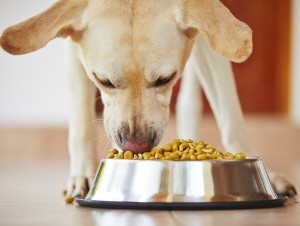This information is provided as the 2nd in our series of fundamental instruction on assuring the health and well-being of your pet’s health. See our 1st blog at :
https://powellvets.com/is-there-anything-i-can-do-to-assure-my-pets-health-2/
What to feed?
1. Analyze commercial pet food choices
Thoroughly investigate the options offered by identifying the real manufacturer of the pet foods you are considering by answering the following questions. Does the manufacturer make the food in its own facility? Does it employ a board-certified veterinary nutritionist? Does it have an American Feed Control Officials (AAFCO) feeding trial statement? Does the pet food bag read “manufactured by” as opposed to “distributed by” or “manufactured for”? Does the company practice strict quality control measures and conduct and publish research on animal nutrition? Many foods are co-packed, or made by several different manufacturers then labeled by the end-of-the-line company that sells it.
A great place to start your research is with the annual pet food manufacturer list published by Whole Dog Journal. An example from its 2013 list was Blue Buffalo, which was reportedly made by five different manufacturers – American Nutrition, C.J. Foods, ProPet, Triple T Foods and Tuffy’s Pet Foods. Recently Blue Buffalo built a multi-million dollar facility of its own in Missouri with the idea of bringing its product in house.
The flip side of co-packing is mass manufacturing. Take Diamond Pet Foods, for example, the manufacturer behind at least 30 different pet foods, including Chicken Soup for the Pet Lover’s Soul, Canidae, Kirkland, Solid Gold Wolf King, Taste of the Wild, 4 Health, Professional and Premium Edge, to name a few. Diamond Pet Foods’ Gaston, South Carolina, plant was also home to a national Salmonella enterica outbreak, which led to the largest recall of dry pet foods. More than 30,000 tons manufacturer if it implements routine testing as part of its quality standards.of food were recalled after a New Jersey infant became severely ill from contact with Costco’s Kirkland brand pet food. Most recently (2012), a sample of Diamond Pet foods’ lamb-based food from its Meta, Missouri, plant tested positive for Salmonella Liverpool, but no human illness was reported? Why such ongoing problems? Unfortunately regulatory agencies don’t require manufacturers to test their final pet food products for Salmonella. That’s why it’s important to ask your favorite manufacturer if it implements routine testing as part of its quality standards.
It’s important to fight the daily battle against misleading marketing and Internet “knowledge” to provide clients with the best possible information about their pet’s health. Although this blog does not purport to offer any recommendations, for those who place their trust in our knowledge and would like recommendations, we offer information from Dr. Jeromin* for this information today. “In my practice I recommend the larger pet food manufacturers including Hill’s, Iams, Royal Canin and Nestle Purina. These companies generally manufacture in house, employ board-certified veterinary nutritionists, publish nutritional research to peer-reviewed journals, adhere to strict quality-control measures, actually feed their food via AAFCO feeding trials (not all companies do this) and can provide a complete nutritional analysis of their products. When there is control of all aspects of research, development and manufacturing, there is a sense of pride and responsibility for the products these companies are offering our pets.”
______________________________________________________________________
Did you know?
If you hear a pet food manufacturer tout its product as “veterinarian-approved,” don’t be fooled! It turns out that veterinarian-approved is not a term allowed on pet food labels. “Veterinarians do not approve labels or products, only state regulatory agencies can do that,” according to the Associate of American Feed Control Officials. Pet food manufacturers can, however, use the terms, “veterinarian-recommended,” “veterinarian-developed” or “veterinarian-formulated” if the company meets certain criteria set out by the association.
_______________________________________________________________________
2. Familiarize yourself with fad diets
“Grain-free” is the new buzzword for pet owners. The problem is that grain-free does not mean hypoallergenic and there is no set AAFCO definition of “grain-free.” So grain-free can mean different things to different manufacturers. What many owners don’t realize is that dogs are of the carnivore species but are omnivores in their eating habits, so complex carbohydrates are actually necessary for normal stool formation. Obesity often thought to be a problem with high-carbohydrate foods is actually more of a concern with high-fat diets.
Many of today’s pet owners are also gravitating toward raw food diets because “that’s what animals eat in the wild” and “it’s natural.” Of the 36 regions of genomes that differ between wolves and dogs, 10 play a role in digestion, metabolism, indicating legitimate nutritional differences between the two. Wild animals have a short lifespan, and these raw diets may not provide proper and complete nutrition for the long life our domestic pets enjoy.
Unfortunately most reports concerning raw diets are anecdotal with a lack of long-term, high-quality studies. Most raw diets are labeled as supplements or for intermittent feeding only—not for long term nutrition. A recent article reviewed the scientific evidence for and against raw diets and reported 60 percent of recipes used in homemade raw diets were found to have nutritional imbalances. In an earlier study, all five raw diets (three home-cooked, two commercially prepared) tested had an incorrect calcium/phosphorous ratio, vitamin A and E deficiencies and twice the AAFCO-recommended amount of vitamin D.
“Enzymes” are another touted benefit of raw diets, yet most dogs and cats do not require exogenous enzymes for digestion. Some pets receiving raw diets do have improved digestion, as heat commonly used in manufacturing commercials pet foods can affect protein digestibility but improves plant digestibility.
Excerpts from “Pet Food facts and fiction” dvm360 March 2015 Volume 46 Number 3 dvm360.com
*Dr. Jeromin is a pharmacist and veterinary dermatologist in private practice in Cleveland, Ohio. She is a 1989 graduate of The Ohio State University College of Veterinary Medicine and an adjunct professor at Case Western Reserve University’s College of Medicine.
How often and how much to feed?
 Our recommendations for your pet will vary depending upon your pet’s age, breed, activity level, metabolism and your own schedule. Whether you feed your pet once or twice daily, make sure to feed him at the same time each day and provide fresh drinking water at all times. Consistency in food type, amount and feeding time is critical for your pet’s health. Do your best to develop a feeding plan that emphasizes regularity to help your pet’s digestive health to remain in peak condition.
Our recommendations for your pet will vary depending upon your pet’s age, breed, activity level, metabolism and your own schedule. Whether you feed your pet once or twice daily, make sure to feed him at the same time each day and provide fresh drinking water at all times. Consistency in food type, amount and feeding time is critical for your pet’s health. Do your best to develop a feeding plan that emphasizes regularity to help your pet’s digestive health to remain in peak condition.
As a general rule, puppies or kittens burn more calories, so they need a greater quantity of food that is higher in protein and fat. Older, less active pets require fewer calories to remain healthy. Richard H. Pitcairn, DVM, PhD, author of Dr. Pitcairn’s Complete Guide to Natural Health for Dogs and Cats, believes the most reliable approach is to feed what seems to be a reasonable amount and monitor his body weight. “You should be able to feel your pet’s ribs easily as you slide your hand over his sides,” Pitcairn says. “If you can’t, he’s probably too heavy, so begin to feed 25% less.”
If you’re using a commercial pet food, beware of the “feeding guidelines” on the bag or box. It lists different weights and the corresponding amount of food to feed your pet to maintain that weight, and should be used only as a rough guideline. Many pets are overweight because their families closely followed the directions on the label, which often indicates portion sizes that are too large. After all, the sooner the bag is empty, the sooner you will need to buy more food.
Though it may sound counterintuitive, as a general rule, large breed dogs require less food and small breed dogs require more food when expressed on a volume of food per pound of body weight. The food requirements of individual dogs vary according to their health, level of activity, and age.
Different portions for different animals
Puppies and kittens: Puppies are typically introduced to solid food at four to six weeks of age and are completely weaned from their mother’s milk by eight weeks. Puppies require a diet that is higher in protein and other nutrients to support normal growth and development. If you are feeding commercial pet food to your puppy, select a brand that is specially formulated for puppies. Young puppies should be fed at least three times a day — morning, noon, and early evening — until their food requirements per pound of body weight begin to level off as they mature. By the time the puppy is five or six months of age, his feeding schedule can be reduced to twice a day. If you have a finicky puppy, you can add some warm water to dry food to encourage him to eat it. Cow’s milk can act as a laxative and cause digestive problems for some puppies and adult dogs, so avoid giving this to your pup or only give very small amounts. If your puppy doesn’t eat all his moistened food within a few hours, discard the uneaten portion before it goes bad. The amount of food you feed your puppy will vary depending upon his size, activity, metabolism, and environment. Feeding too much can not only lead to a pudgy pup, but can also cause bone abnormalities and other health issues. If your puppy appears to be gaining too much weight, gradually decrease his food intake by 25% less, but if his ribs are showing, increase his portions by 25%. If you are unsure about his proper weight or appearance, talk to your vet for guidance. Cats on the other hand are often free feeders often visiting their cat dish every couple of hours and do well with this routine. However, for the overweight feline they should be fed as for above to limit their intake.
Adults: When the average dog is one year old, he has reached full maturity and enters a “maintenance period.” This means that his nutritional requirements will stay about the same during his young adult life, assuming he is not ill or engaging in extreme physical exercise. His weight should remain stable and his body should be well-proportioned — he should have an observable waist and you should be able to feel his ribs with your fingertips, beneath a thin layer of fat. If you are feeding your adult pet a commercial pet food, select one that is specially formulated for adult pets.
As with humans, a pet’s appetite may vary from day to day. This is not cause for alarm unless his loss of appetite persists for several days or he shows obvious signs of weight loss or illness. However, having no desire to eat can be the first sign of many illnesses, so monitor your pet’s food and water intake carefully. You know your pet best, so if something seems amiss, don’t hesitate to take him to his vet.
Active adults: Moderate exercise is essential for all pets and helps them remain fit and trim throughout their lifetime. But some pets, like some humans, will regularly do more intense exercising. If your pet is particularly active (for instance, if he jogs or runs with you regularly, or is involved in sporting activities) his energy needs will be greater than those of his more sedentary counterparts. Be aware, though, when a typically active pet is less active (for instance, an inside pet during the cold winter months (outdoor pets may require more food in the cold winter months) or when he suffers an injury, such as a sprain or muscle pull), his food requirements decrease. In these instances, experts recommend gradually changing to a lower energy, less nutrient-dense pet food.
Very active dogs should not be fed immediately before or immediately after a strenuous workout. This can lead to digestion problems or discomfort (such as vomiting or loose stools) and may increase the risk of gastric bloat, a painful and often life-threatening condition caused by a twisting of the stomach (torsion or GDV).
Although a small meal can be provided in the morning, hard-working dogs should receive the bulk of their daily calories one hour or more following their last exercise session each day. You can also feed your dog small snacks or treats during periods of increased activity to prevent hunger and fatigue. Allow him to rest intermittently and make sure he has access to fresh water at all times.
Seniors: As with humans, the dietary requirements of pets will change as they age. Elderly pets have reduced energy requirements and therefore shouldn’t consume the same quantity of food as they did when they were younger. If you’re feeding your senior pet commercial pet food, look for brands that offer reduced calories while still including all the necessary nutrients. Senior pets, like all pets, should be fed according to their overall health and level of activity. A less active pet can quickly gain weight if you’re not careful.
Hopefully this guide helps you create a healthy feeding plan for your dog.



WORKING HOURS:
Monday-Friday 8:00am - 5:00pm
Saturday 8:00am - 12:00 noon